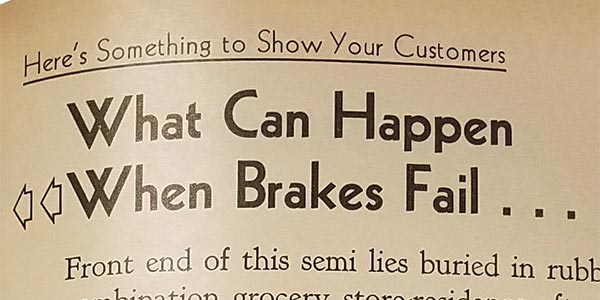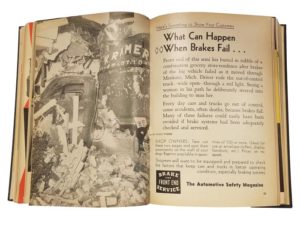BRAKE & FRONT END, July 1956: In the 1950s, Brake & Front End published a series of posters that could be cut out from the magazine and displayed in shops to show customers the possible results of neglecting their brakes. These posters were designed around a simple concept: The more dramatic, the better. The pictures did not show mangled bodies, but the vehicle wreckage left behind after a crash. Local freelance newspaper photographers supplied most of these pictures.
In 1956, 37,955 people were killed in traffic accidents. In 2016, only 40,202 people were killed in traffic accidents. While this is not a reduction, it is progress. In the past sixty years, the number of vehicles registered and miles driven annually has seen a five-fold increase. Improved roads and vehicle design have helped to reduce the fallout from vehicle accidents, but proactive technicians are still at the heart of improved driver safety.
Transcript: “Here’s Something to Show Your Customers. What Can Happen When Brakes Fail. Front end of this semi lies buried in rubble of a combination grocery store-residence after brakes of the big vehicle failed as it moved through Mankato, Mich. Driver rode the out-of-control truck – wide open – through a red light. Seeing a woman in his path he deliberately steered into the building to miss her.
Every day cars and trucks go out of control, cause accidents, often deaths, because brakes fail. Many of these failures could have easily been avoided if brake systems had been adequately checked and serviced.
SHOP OWNERS: Tear out these two pages and post them prominently on the wall of your shop. Reprints available in quantities of 100 or more. (Ideal for use as envelope stuffers, display handouts, etc.) Prices on request)
Shopmen will want to be equipped and prepared to check the factors that keep cars and trucks in better operating condition, especially brake systems.
Brake and Front End Service, The Automotive Safety Magazine”















